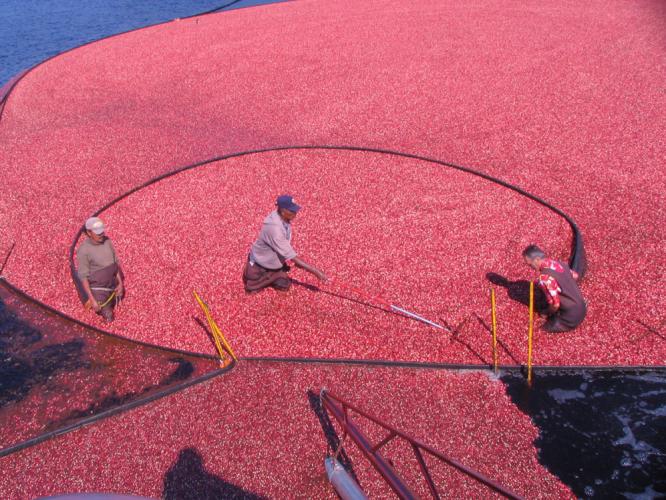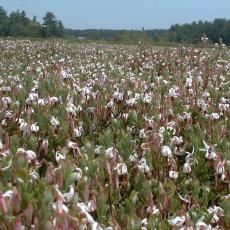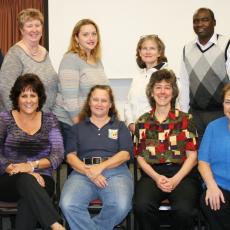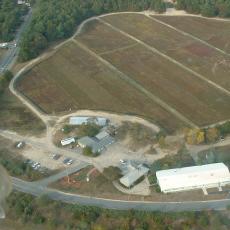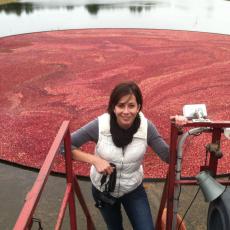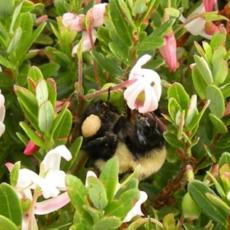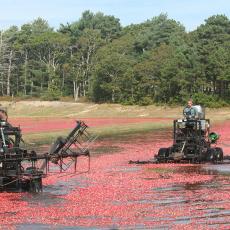In Our Spotlight
University of Massachusetts Cranberry Station
Ahhh, cranberries. The very word conjures up an abundant Thanksgiving table, rich with the sights, smells, and tastes of a traditional Fall feast. This tiny fruit has become one of America’s gastronomic icons. However, with so many new cranberry-infused products on the market -- from juices to dried fruit to trail mix and snacks of all kinds -- enjoyment of cranberries has extended well beyond the November holiday.
A few fun facts:
- Only six to seven percent of the season’s cranberries grown in the United States are sold by the time our November holiday rolls around.
- The University of Massachusetts “state bog” in southeastern Massachusetts, just before you reach Cape Cod, totals eighteen acres.
- Cranberries are rooted deeply in the Commonwealth’s heritage. Cranberry bogs are defining features of the southeastern region’s landscape…it is no accident that this area is known as “cranberry country.”
- And finally, Massachusetts is currently the second largest producer of cranberries in the United States.
This tart red autumn berry is revered nowhere more than at the University of Massachusetts Cranberry Station in East Wareham. Anyone who enjoys cranberry sauce, a glass of cranberry juice or dried cranberries will be happy to know that UMass researchers near Cape Cod focus their time exclusively on understanding how to grow them most effectively. For example, insects that damage these berries are thoroughly studied. Methods to manage pests, including the use of Integrated Pest Management (IPM) techniques, are embedded in their work. Public grower education is provided through Extension efforts. And the economy around growing, selling and caring for this small fruit is celebrated, as it has been for over a century.
The UMass Cranberry Station’s mission is well-defined and results of their dedication are impressive.
Strong Economic Benefits, Some Health Qualities, and New Challenges
Why is this hollow[JS1] little fruit of such interest to the Commonwealth? Beyond a unique taste (with possible health benefits), it is a matter of simple economics. The cranberry industry plays an important role in our state’s economy and heritage with UMass research efforts playing a big part of the success story. According to the Cape Cod Cranberry Growers’ Association 2015 report, cranberries are the largest agricultural food commodity produced in the state with an annual crop value of $99.8 million dollars. Massachusetts is home to 30% of all cranberry acreage as well as the two largest cranberry handling companies in the world. This industry provides over 6,900 jobs and a total economic benefit of over $1.4 billion in the state. Cranberry farms are a critical source of tax revenue for many local communities.
In addition to economic benefits, Massachusetts cranberry farmers own and maintain a combined total of over 60,000 acres of bogs and surrounding support lands. This ownership helps to protect open space, provides environmental benefits, and even promotes tourism.
Cranberries have been dubbed a “super food.” An online resource, WebMD, posts: “Cranberries have vitamin C and fiber, and are only 45 calories per cup. In disease-fighting antioxidants, cranberries outrank nearly every fruit and vegetable--including strawberries, spinach, broccoli, red grapes, apples, raspberries, and cherries.” Long-touted health benefits of consuming cranberry juice to decrease urinary tract infections (UTIs) were recently questioned by the Cleveland Clinic. “There is an active ingredient in cranberries that can prevent adherence of bacteria to the bladder wall, particularly E. coli,” says urologist Courtenay Moore, MD. “But most of the studies have shown that juice and supplements don’t have enough of this active ingredient, A-type proanthocyanidins (PACs), to prevent bacteria from sticking to the urinary tract.” Still, she says, “The bottom line? Cranberry can’t hurt, and it may help.” She says it may be worth trying if you struggle with UTIs since the risk in doing so is very low.
Today the Massachusetts cranberry industry is challenged by one of the most significant economic crises it has faced in its 199-year history: housing development with inevitable urban sprawl. The town of Carver, with approximately 11,900 total acres of bogs and related lands (representing 48 percent of total land area in town), is the single largest cranberry-producing town in the Commonwealth. It is also one of ten Massachusetts towns experiencing an uptick in housing growth, putting development pressure on bogs. Such scenarios threaten the immediate viability for many growers in Massachusetts and the long-term horizon for the industry.
Cranberry Research
Research is at the heart of the Cranberry Station, powering their ability to provide high-quality, science-based information to cranberry growers. Station scientists are leaders in the cranberry research community and in their scientific disciplines.
Kirby Gilmore, a second-generation cranberry grower who owns bogs in Rochester and Carver, responded to a question about the benefit of the Cranberry Station is to his operation by saying, “It is our home. There is always an open door and researchers to talk with. Without this resource, we’d be in big trouble.”
Research conducted onsite is some of the highest-regarded in the nation. Just a handful of other university facilities perform cranberry research, including University of Wisconsin-Extension, Oregon State University, Rutgers University, New Jersey and Washington State University. But the UMass Cranberry Research Station offers a comprehensive focus, entirely on the cranberry. The station’s researchers and staff are a model for the integration of research and extension and function well as a multidisciplinary collaborative group.
The scope of services and topics covered at UMass Cranberry Station is wide. For example, staff provides diagnostic services (disease, insect, plant nutrition, weeds) relating to cranberry production for growers. They offer outreach programs to residents of Massachusetts and cranberry growers. Their core work advances knowledge of cranberry-related sciences including entomology, plant pathology, weed science, and basic and applied plant sciences, including plant nutrition and plant physiology. To carry out this mission and work, seven professionals work at the Station, along with twelve support staff.
UMass entomologist Anne Averill is taking the lead on a five-year “Specialty Crop Project” funded by USDA’s National Institute of Food and Agriculture (NIFA). This $3.3 million effort involves several institutions and crops, with the University of Massachusetts as the lead partner. The objectives are to understand the role, health, and pollination economics of the bee community in tree and berry crops as well as cucurbits (squash, pumpkins) and to develop recommendations for growers to protect pollinator diversity. This is one example of many research projects the Cranberry Station undertakes collaboratively, with results then disseminated nationwide.
The Massachusetts state bog grows eight different varieties of cranberry. Early Black and Howes are native selections from Mass. Others are native to Wisconsin or elsewhere. They include: Ben Lear, Stevens, Grygleski #1, and three recent hybrids released by Rutgers University - Crimson Queen, Mullica Queen, and Demoranville (named for Irving DeMoranville, the father of the current Director, who was a long-time Director of the Cranberry Station). State wide, the predominant acres are in Early Black and Howes (~50%), then Stevens (~30%),then Ben Lear (~10%).
The rich 110 year history of the UMass Cranberry Station is underscored by the continued use of the century-old cranberry separator used to sort berries and the reproduction wooden scoops used to harvest plots.
Current Cranberry Station Researchers and Projects
UMass researchers bring extraordinary experience to bear on cranberry research.
Carolyn DeMoranville, Station director and specialist in cranberry plant nutrition, leads all efforts onsite. From obtaining grants totaling more than $2 million, to ensuring success of cutting-edge research, to acting as liaison to the public, she runs a tight ship. DeMoranville concentrates her research efforts on plant nutrient management. Her personal research includes identifying ways to increase efficiency of nutrient use and minimizing the nutrient impacts on water quality.
Hilary Sandler was recently awarded two grants from EPA to continue her research into integrated weed management, focusing on incorporating multiple techniques, including the use of hand-held flame cultivation, to control woody perennial weeds and the parasitic plant, dodder.
Anne Averill, an entomologist, spends her days with bees. She examines native bees (which are abundant in bogs) as she looks at the diversity in the pollens they collect and at the pathogens that can infest these bees. Averill also helps identify ways that growers can manage pest insects without harming the beneficial pollinators. The third area of her investigation is to assess bumble bee colony growth and fitness as she compared commercial bogs to conservation (unmanaged) areas. In summary, the results were quite similar.
Peter Jeranyama, an environmental physiologist, is the water guy. He measures moisture in the soil with constant monitoring devices and develops parameters for how remote irrigation should be triggered. He also looks at how growers can cycle irrigation pumps when using them to prevent frost damage. When these ideas are implemented and tied to automated systems, growers can trigger and monitor irrigation and frost protection remotely (via smart phone).
Hang Xiao (from UMass Amherst’s Department of Food Science) and Catherine Neto (from UMass Dartmouth’s Department of Chemistry and Biochemistry) are studying colon cancer inhibition by cranberry fractions. Their study uses a mouse model to review the effect of feeding dietary cranberry on the progression of colon cancer. Preliminary results are promising, with a reduction in 50% of colon tumors and a substantial decrease in inflammation.
Erika Saalau Rojas, a plant pathologist, works on understanding fruit rot and other cranberry diseases. She is the newest member of the Station faculty, arriving in 2014. In this past year she was instrumental in establishing a Cranberry Fruit Rot Working Group, funded by the Northeastern IPM Center. The working group has already created a list of the most important cranberry diseases by region. They also developed a list of needs and research priorities to help coordinate and direct all research efforts towards a solution for new and improved strategies to combat fruit rot.
Casey Kennedy, a hydrologist from USDA’s Agricultural Research Service, conducts research on the water and nutrient management of cranberry farms. His broader research interests include water quality, isotope hydrology, groundwater-surface water interaction, and subsurface drainage management. He has been studying harvest floods to determine pathways of nutrient movement and has meen mentoring a graduate student who is characterizing seasonal nutrient movement in bogs with tile drains installed.
New Publication for Cranberry Growers
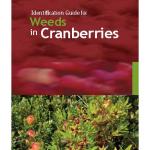 The Station is offering a recently-published book for purchase: Identification Guide for Weeds in Cranberries. The translation and expansion of this guide from the orginal French version was coordinated by Hilary Sander.
The Station is offering a recently-published book for purchase: Identification Guide for Weeds in Cranberries. The translation and expansion of this guide from the orginal French version was coordinated by Hilary Sander.
This guide brings together high-quality photographs with descriptions for 144 weeds commonly found throughout the North American cranberry growing regions. It contains nearly 1,000 photographs that illustrate botanical characteristics of weed species at different stages of development. Sample pages.
For more information on this publication, the Station’s newsletter, and other Station activities, visit their website.
